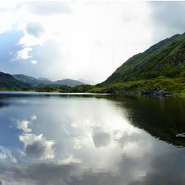Posted 30 August 2013
Kerry lake acted as Ice Age gene pool for fish
Scientists have reconstructed the genetic origin of an endangered fish found only in a lake in Kerry, Ireland. The genetic history of the aptly named ‘Killarney shad’ provides evidence for the timing of the colonisation of the lake by the fish after the last glaciations.
Under certain conditions, the link between the rivers and the sea can become blocked by natural processes or human intervention (the building of locks or weirs along a water course), and fish may consequently become trapped or ‘landlocked’ in freshwater lakes.
There are several examples of landlocked fish populations which have since adapted to living permanently in freshwater environments, but the evolutionary processes that lead to their origin have rarely been reconstructed.
The findings by researchers from University College Dublin, the University of Salford and Inland Fisheries Ireland, published in the journal Molecular Phylogenetics and Evolution show that after the end of the last ice age, some twaite shad were trapped in the lake on two separate occasions: the first coincided with the retreat of the glacial ice sheet from the south west of Ireland some 16,000 years ago; and the second occurred around 7,000 years ago.
The descendants of these colonising fish interbred and gave rise to the Killarney shad, a distinct ‘dwarf’ variant characterised by its smaller body size and a lower number of rakers along its gill arches.

Pictured: Killarney shad, known locally as the 'goureen'
(Credit:: Willie Roche, Inland Fisheries Ireland)
Today, there are no natural or manmade barriers between Lough Leane and the sea – but the Killarney shad has become so adapted to its new habitat that no migration to the sea is needed for the completion of its life cycle.
The Killarney shad is the only example of landlocked shad to have survived in North Western Europe. It is listed as critically endangered on the IUCN Red List and the Killarney National Park where the lake is located has been designated as a Special Area of conservation (SAC) for the shad, but its survival continues to be threatened by invasive species and eutrophication.
While the researchers have shown the Killarney shad to be present in Lough Leane for thousands of years, the fish was only formally reported in 1911 by fisheries scientist Mr Tate Regan. The fish is known locally as the ‘goureen’.
The research was funded by the Irish Research Council, with support from Inland Fisheries Ireland, and was part of Dr Ilaria Coscia’s PhD at University College Dublin supervised by Professor Stefano Mariani, who is now Professor of Conservation Genetics at the University of Salford.
Dr. Cathal Gallagher, Head of R&D at Inland Fisheries Ireland, identified that Inland Fisheries Ireland was delighted to have contributed to this investigation. He pointed to the importance of state agencies working with third level institutes, bringing a combination of applied and academic expertise to bear on issues of mutual interest.
(Produced by UCD University Relations)

